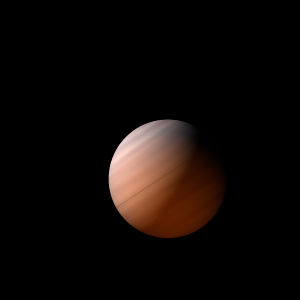|
|
Space Astro
|
Info for exoplanet "Nyado-fu"
| Scientific (actual) data |
|---|
| Planet | GJ 3021 b |
| Planet status | Confirmed |
| Mass sini | 3.37 |
| Orbital period | 133.71 |
| Semi major axis | 0.49 |
| Orbit eccentricity | 0.511 |
| Angular distance | 0.027809 |
| Discovered | 2000 |
| Updated | 2023-04-17 |
| Omega | 290.7 |
| Tperi | 2451550 |
| Publication | Published in a refereed paper |
| Detection type | Radial Velocity |
| Alternate names | SAO 258219 b, HIP 1292 b, TYC 9354-00780-1 b, 2MASS J00161266-7951042 b, HD 1237 b |
| Star name | GJ 3021 |
| Right ascension | 4.05° |
| Declination | -79.85° |
| Mag v | 6.59 |
| Star distance | 17.62 |
| Star metallicity | 0.1 |
| Star mass | 0.9 |
| Star radius | 0.9 |
| Star sp type | G6 V |
| Star age | 8.77 |
| Star temperature | 5540 |
| Wikipedia article | GJ 3021 b |
Back
| |
| Fictional info (?) |
|---|
| Suggested name | Nyado-fu |
| Planet type | Cold planet |
| It is the second-brightest natural object in the night sky after Kegyu-mi, reaching an apparent magnitude of -5 - bright enough to cast shadows at night and, often, visible to the naked eye in broad daylight.
It is named after the deity Nyado-fu, the demon of nature.
Nyado-fu is a cold planet and is sometimes called Kegyu-mi's "sister planet" because of their similar size, mass, proximity to GJ 3021, and bulk composition.
As one of the brightest objects in the sky, Nyado-fu has been a major fixture in native folklore for as long as records have existed.
The rotational period and seasonal cycles of Nyado-fu are likewise similar to those of Earth, as is the tilt that produces the seasons.
Its north and south poles, therefore, lie where most other planets have their equators. |
| Atmosphere | Ammonia | 81% |
| Hydrogen peroxide | 19% |
| Ammonium hydrosulfide (NH4SH) | 0.27% |
| Atmospheric pressure | 0.07 bar |
 |
| No known satellites |
| Google search for Nyado-fu |
|
Website by Joachim Michaelis
|
|
|
|